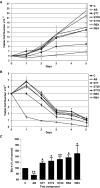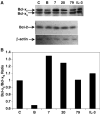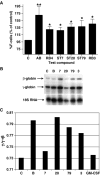Enhancement of growth and survival and alterations in Bcl-family proteins in beta-thalassemic erythroid progenitors by novel short-chain fatty acid derivatives
- PMID: 16099182
- PMCID: PMC4260805
- DOI: 10.1016/j.bcmd.2005.06.007
Enhancement of growth and survival and alterations in Bcl-family proteins in beta-thalassemic erythroid progenitors by novel short-chain fatty acid derivatives
Abstract
Accelerated apoptosis of erythroid progenitors is a characteristic of beta-thalassemia which presents a significant barrier to definitive therapeutic approaches utilizing induction of endogenous fetal globin gene expression. gamma-globin gene expression may not be inducible in, or may not be able to rescue, erythroid cells in which programmed cell death is initiated early in erythroblast development. In this report, short-chain fatty acid derivatives (SCFADs) which induce fetal globin gene expression were tested for their ability to promote proliferation and survival of erythroid progenitors cultured from beta-thalassemic subjects, and of cytokine-dependent erythroid cell lines. Certain SCFADs promoted thalassemic Bfu-e growth and cytokine-independent growth and survival of erythroid cell lines. A 40-80% increase in erythroid Bfu-e colony number was observed in cultures established with any of five mitogenic SCFADs, compared to control or butyrate-treated cultures from the same subjects. Immunoblot analysis demonstrated that these same SCFADs also regulated the expression of specific protein inhibitors of apoptosis. Anti-apoptotic ratios of the proteins Bcl-xL/Bcl-xS in thalassemic Bfu-e were increased by 30-120% with exposure to the SCFDs, compared to the ratios in the same cells cultured under control conditions. Similar anti-apoptotic increases in Mcl-1L/Mcl-1S ratios were induced by the SCFADs. These findings suggest that select fetal globin-inducing SCFADs which enhance proliferation of beta-thalassemia progenitors may enhance survival of these progenitors by altering levels of Bcl-family protein members. This combination of effects should enhance erythroid cell survival in the beta-thalassemia syndromes, allowing fetal globin gene expression to be induced more effectively than currently available, growth-suppressing, fetal globin-inducing agents, such as the butyrates or chemotherapeutic agents.
Figures




Similar articles
-
Induction of fetal globin in beta-thalassemia: Cellular obstacles and molecular progress.Ann N Y Acad Sci. 2005;1054:257-65. doi: 10.1196/annals.1345.033. Ann N Y Acad Sci. 2005. PMID: 16339673 Free PMC article. Clinical Trial.
-
Short-chain fatty acid derivatives stimulate cell proliferation and induce STAT-5 activation.Blood. 2001 May 15;97(10):3259-67. doi: 10.1182/blood.v97.10.3259. Blood. 2001. PMID: 11342457 Free PMC article.
-
Short-chain fatty acid derivatives induce fetal globin expression and erythropoiesis in vivo.Blood. 2002 Dec 15;100(13):4640-8. doi: 10.1182/blood-2002-02-0353. Epub 2002 Aug 15. Blood. 2002. PMID: 12393583 Free PMC article.
-
Cellular and molecular effects of a pulse butyrate regimen and new inducers of globin gene expression and hematopoiesis.Ann N Y Acad Sci. 1998 Jun 30;850:87-99. doi: 10.1111/j.1749-6632.1998.tb10466.x. Ann N Y Acad Sci. 1998. PMID: 9668531 Review.
-
Fetal globin induction in beta-thalassemia.Hemoglobin. 2009;33 Suppl 1:S197-203. doi: 10.3109/03630260903351882. Hemoglobin. 2009. PMID: 20001626 Review.
Cited by
-
An oral HemokineTM, α-methylhydrocinnamate, enhances myeloid and neutrophil recovery following irradiation in vivo.Blood Cells Mol Dis. 2017 Mar;63:1-8. doi: 10.1016/j.bcmd.2016.10.021. Epub 2016 Oct 31. Blood Cells Mol Dis. 2017. PMID: 27888688 Free PMC article.
-
A randomized phase I/II trial of HQK-1001, an oral fetal globin gene inducer, in β-thalassaemia intermedia and HbE/β-thalassaemia.Br J Haematol. 2013 May;161(4):587-93. doi: 10.1111/bjh.12304. Epub 2013 Mar 27. Br J Haematol. 2013. PMID: 23530969 Free PMC article. Clinical Trial.
-
Serum Bcl-2 Levels in Patients with β-Thalassemia Minor: A Pilot Study.Turk J Haematol. 2014 Dec 5;31(4):363-6. doi: 10.4274/tjh.2013.0152. Turk J Haematol. 2014. PMID: 25541652 Free PMC article.
-
Potential anti-genotoxic effect of sodium butyrate to modulate induction of DNA damage by tamoxifen citrate in rat bone marrow cells.Cytotechnology. 2017 Feb;69(1):89-102. doi: 10.1007/s10616-016-0039-2. Epub 2016 Nov 30. Cytotechnology. 2017. PMID: 27905024 Free PMC article.
-
Extracts from Plastrum testudinis promote proliferation of rat bone-marrow-derived mesenchymal stem cells.Cell Prolif. 2007 Apr;40(2):196-212. doi: 10.1111/j.1365-2184.2007.00431.x. Cell Prolif. 2007. PMID: 17472727 Free PMC article.
References
-
- Steinberg MH, Rodgers GP. Pharmacologic modulation of fetal hemoglobin. Medicine. 2001;80:328–344. - PubMed
-
- Collins AF, Pearson HA, Giardina P, Mcdonagh KT, Brusilow SW, Dover GJ. Oral sodium phenylbutyrate therapy in homozygous beta thalassemia: a clinical trial. Blood. 1995;85:39–43. - PubMed
-
- Cappellini MD, et al. Oral isobutyramide therapy in patients with thalassemia intermedia: results of a phase II open study. Blood Cells Mol Dis. 2000;26:105–111. - PubMed
-
- Lowrey CH, Nienhuis AW. Brief report: treatment with azacytidine of patients with end-stage β-thalassemia. N Engl J Med. 1993;329:945. - PubMed
-
- Dunbar C, Travis W, Kan YW, Nienhuis AW. 5-Azacytidine treatment in a beta thalassemia patient unable to be transfused due to multiple allo-antibodies. Br J Haematol. 1989;74:467. - PubMed
Publication types
MeSH terms
Substances
Grants and funding
LinkOut - more resources
Full Text Sources
Other Literature Sources
Research Materials

